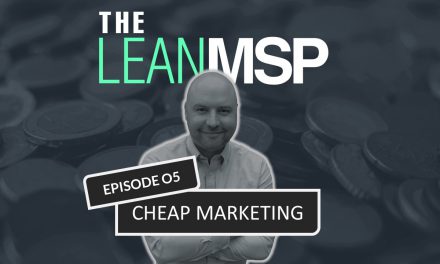It’s been a wild and crazy year for the IT industry. We took a lot of steps forward, a few steps backward, but ultimately I think the industry is trending in the right direction for MSPs. Here are a few of the most notable observations I have made this year into the growing IT ecosystem that we are all a part of:
Remote-Work Accelerates Specialization
I think most would agree that the MSPs that will be left behind from this point forward are the ones that are not willing to adapt to the remote-first, zero-trust, SaaS-enabled landscape that we now find ourselves in. Is there still a market for setting up firewalls, switches, and supporting ground-level infrastructure (which was the “meat and potatoes” of MSPs in years passed)? Of course. But these laborious tasks are gradually getting pushed outside the core value prop of the “Managed Services” model and in some cases can be outsourced to any ready and willing “boots-on-the-ground” found on r/msp or The Tech Tribe.
I mention Nigel Moore’s The Tech Tribe because they have been a step ahead of this trend from the early days of the pandemic. One of the highly underrated features that they launched during this time period was an interactive map that any member could add themselves to. For those looking to outsource onsite project work or vice-versa, this becomes an invaluable resource to connect MSPs with trusted peers to sub-contract labor. While this was probably a small feature rollout and a solution to what seemed to be a temporary resource problem, it could almost become the beginning of a product in itself, enabling the remote-first MSP model of the future. Sure, I know there are vendors offering sub-contracted labor as a service, but some MSPs prefer to deal direct with their peers and I personally have always had a similar preference.
At the same time that the industry is trending remote, it’s also becoming more specialized. This remote landscape now opens up real opportunities in vertical specialization as the geo-fences are lifted and in-person expectations are reduced. A US-based MSP specializing in the “Dental” industry for example, can now sell to the 201,000 Dentists in the country, and provide niche services that only a vertically focused MSP could provide. This allows the MSP to develop a tighter market-fit for their services while also expanding their reach at the same time.
The Ultimate Guide To Cash Flow For Managed Services
Sponsored by Alternative Payments & Zest
Media & Channel Platforms Are Decentralizing
As this specialization continues to accelerate, we also find ourselves in an industry that is far more decentralized than it once was. The major media outlets that once acted as the voice and/or face of the IT industry have taken a back seat to smaller communities and thought leaders that have become primary spheres of influence in the eyes of the MSP. Both emerging and mid-size vendors are choosing the community route and content collaboration to reach their audiences, as opposed to traditional events and ad placements that were once coveted real estate.
Just look at George Bardissi and MSP Initiative’s Channel Strong Tour. What started as a pandemic pivot has now turned into a new go-to-market platform for emerging vendors and to no one’s surprise, “cornhole and beer” is actually a great way to engage with MSPs. A few other vendors that are building less transactional, but just as engaging platforms of their own are OIT VoIP and Ray Orsini’s “The Tech Bar”, as well as NinjaOne and Jonathan Crowe / Tom Watson‘s “MSP Live Chat.” All of these platforms have taken the content and engagement direct to MSPs and essentially cut out the intermediaries that were once responsible for delivering it. Sure, everyone has a podcast these days, but the aforementioned names have been able to leverage these “from-scratch” platforms to achieve consistent visibility, and achieve tangible audience growth by their own doing. More importantly, they lifted others up around them, and their generosity is being rewarded.
On the MSP side, it appears that the larger MSP community groups get, the more new smaller ones seem to pop-up. Many of these newly-found groups are taking on completely unique identities, different values, and even different revenue models. Membership data would probably say otherwise, but anecdotally it seems that MSPs prefer to engage in smaller communities organized by other former or current MSPs and consultants as opposed to those owned, operated, or acquired by large IT software vendors. This to me is a sign of a healthy ecosystem, trying to organize itself into groups upon which members feel the most comfortable and get the most value.
MSP Influencers Have A Real Voice
While some communities exist in the form of a forum, social group or gated network, others exist without boundaries. I have noticed many MSPs engaging with each other in the comment sections of Twitter, LinkedIn and YouTube, forming their own nomadic bands of influence. While these relationships may have been formed behind a community wall, they are certainly spilling over into public territory and providing real value to those in their path.
I got to witness this first-hand the last few weeks as I watched a handful of MSP Influencers self-police vendors for their response to the log4j vulnerability. From calling vendors out on their distasteful sales tactics, to exposing those who tried to claim credit for open-source projects, these MSPs were letting their voices be heard in front of thousands of industry peers and forcing vendors to respond. This power shift matters. Let’s be honest, MSPs get the short-end of the stick a lot of the time when it comes to their vendor relationships, but few have ever had the ability to do anything about it. That’s changing, and we are starting to develop an organic system of checks and balances being brought on by vocal leaders who genuinely want what’s best for MSPs and their peers.
A few MSP Influencers that I have enjoyed watching this year are Kelvin Tegelaar , Tom Lawrence, and Matthew Fox. Each has their own niche (cybersecurity, infrastructure, & marketing respectively) and has proven to be able to provide consistent value to their peers. While these influencers probably rely on Managed Service income and/or affiliate sponsorships to fund their platforms, I think a true decentralized ecosystem would favor more direct transactional support between MSPs and the influencers they follow. If we want them to give us their raw opinions without any vendor-spin or bias, then we have to (and should) pick up the tab. It’s my hope that this is something we see more of next year.
The Ultimate Guide To Cash Flow For Managed Services
Sponsored by Alternative Payments & Zest
Vendor Diversification Is A Good Thing
Back in January of 2021 I did an interview with Jay McBain of Forrester, who told me that “there are about 2,000 companies with a relatively mature MSP program, 8,000 more that are building, and 17,000 more that are just getting started.” I reached out to him again today to see if there has been any change in these figures and was blown away by his response. He now sees a “surge in security company programs and emerging technologies” which equates to his latest estimate of “35,000 channel-focused companies (in tech industry).” This is almost a 30% increase over the course of a single year.
While on the surface all of this vendor “noise” can be frustrating for the MSPs, it’s actually exactly what the market needs. In order for MSPs to truly differentiate themselves, they need to have the freedom of choice as they are building out their technology stack and specializing it to their customer base. Some of these emerging vendors are more visible than others, as they are integrating with each other, collaborating on content and events, and even forming their own back-channel communities as I mentioned before. These collaborations give vendors with lesser resources the platforms they need to reach the MSP market directly and in return the MSPs get visibility into emerging tech without ever having to walk the exhibit-room floor. They also get to build more tight-knit partner relationships with vendor Founders and Decision Makers, and influence product development in a way that they never could before.
A few people I am watching closely that appear to be trying to actively diversify the vendor market are Kevin Lancaster and Matt Solomon of Channel Program. I was unable to attend their first “Channel Pitch” event, but I did talk to a few MSPs who definitely appreciated the condensed format and focus on emerging and innovative vendors. I personally would love to see these pitches organized into product categories, allowing MSPs to compare specific solutions in a more engaging and less time consuming way, so I am looking forward to seeing where they go with it once they open up the rest of the platform.
IT Marketing Is An Industry In Itself
In a more selfish observation, I am starting to recognize that the Marketing sector of the IT Channel is finally maturing into an ecosystem in itself. I first started to get this feeling as we were compiling last year’s edition of the “MSP Growth Guide” and were able to spotlight over 60 providers that are fueling the growth of the MSP market. Since that time, I’ve seen almost double that amount that didn’t make our list, some brand new and others that simply weren’t as visible. These take the shape of SaaS products, agencies, service providers, consultants, and even sales & marketing-focused communities like MSP Spark.
Next year, I expect this growth to continue and I believe some of the leading Marketing providers in the industry will come together to deliver more self-sufficient platforms to the benefit of the MSP. While IT Marketers have traditionally relied on the platforms of large IT vendors to reach new audiences, there is now enough diversity in the niche to warrant larger-scale collaborations of the size we have not seen before. This could take the shape of Marketing specific in-person or virtual events, interoperability of services, cross-provider service bundling, and even decentralized platforms / marketplaces. While this may not all happen in 2022, many of the seeds have already been planted and maturity to this scale is almost inevitable.
I can also say this with confidence because one of our goals for next year is to help make this happen by acting as the glue that brings this subsection of the IT Channel together and do so in a way that truly benefits the MSP. The more knowledge and resources we can share, the more we can advance our offerings to help MSPs sell and market their services with success. MSP Spark is ground zero for this initiative as we are bringing together some of the leading voices in MSP Marketing from both MSP and Agency/ Consultant sides and giving them a platform to innovate and share ideas.
My Outlook Has Never Been Brighter
You may disagree with some or all of these observations, but that ultimately proves the point I am trying to make. There is no longer a single pane of glass upon which the IT Industry can be viewed. There are many different perspectives, each of them telling a story of their own, narrated by a voice that we would have never heard before. This kaleidoscope effect is what makes today’s IT industry so exciting, as there is always someone new to meet and something new to learn.
What this also means is that whether you are a MSP, Vendor, Consultant, (or something else entirely), you don’t have to “ask permission” to become someone in the IT industry. You simply need to have something valuable to say and the guts to keep repeating yourself until the right people start to listen. If your message resonates, there are no shortage of champions willing to lift you up and to me, that is an industry I am excited to be a small part of in 2022.

SPONSORED BY ZEST

















